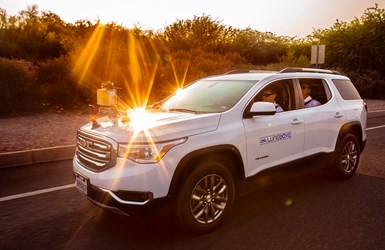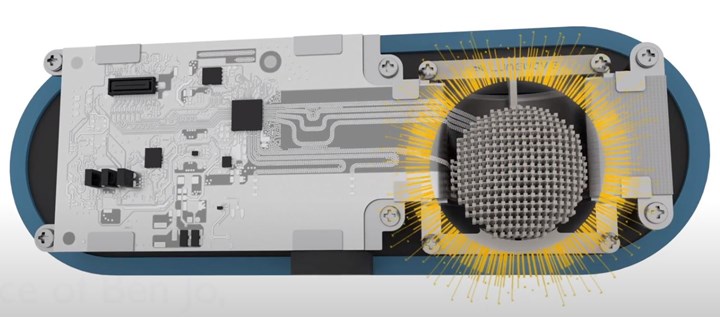Lunewave Touts Enhanced Radar
Startup lands new funding as it nears commercialization, 3D-printing is key
Lunewave, a Tucson-based startup, is moving forward with plans to commercialize advanced radar technology that the company claims will provide significant performance—six times the resolution and twice the distance—and cost benefits over current systems.
The company says it is in talks with several potential Tier 1 supplier partners and hopes to announce a deal by next March. That would put it on track to launch the radar for use in low-volume applications by mid-2022, according to CEO and co-founder John Xin.
Leveling Up

(Image: Lunewave)
The first applications will target emerging Level 3-5 autonomous driving systems for robo-taxis, last-mile delivery vehicles, construction trucks and other specialty models.
Lunewave also is developing a base system that can be used for current advanced driver-assist systems. That radar is expected to debut in 2024, Xin says.
How it Works
Lunewave’s system is based on a concept developed by German scientist Rudolf Luneburg in the late 1940s that features a sphere-shaped antenna. The design enables a broader field of view with consistent performance across the spectrum.

Comprised of 6,500 chambers, the Lunewave system is about the size of a golf ball. The lens provides “high gain” and the capability of forming multiple beams in all directions, according to the supplier.
“The antenna is our core IP (intellectual property), plus the sensor algorithms that allow faster signal processing,” Xin says, noting that the company has about eight broad-based patents for the technology and is filing more.
Benefits
Current radar is limited to a 60°-100° field of view (fov), with an angular resolution of 2°-3°. Long-range radar tops out at about 150 m (492 ft).
By comparison, Lunewave’s system can provide:
- 180°, 270° or 360° fov, depending on where it’s mounted
- 0.5° resolution (the lower, the better)
- 300 m (984 ft) range
In addition to the improved resolution, Lunewave’s quality is maintained across the entire field. This differs from traditional radar, which deteriorates significantly outside a narrow central band—an effect that Xin refers to as “tunnel vision.”

As a result, Lunewave says one of its antennas can replace six to nine traditional radar units. In a high-end vehicle with semi-autonomous driving capability, this means 2-4 Lunewave units could do the job of as many as 20 sensors.
Fewer sensors also means less complexity, lower power consumption and less processing power to coordinate the various data inputs, Xin notes.
The new radar can be packaged in the same space as current systems, he adds.
Costs are expected to be comparable on a one-to-one basis, which means a Lunewave array could significantly lower the overall system’s cost.
Sensor Fusion
While Lunewave offers benefits over current radar, Xin still advocates a multi-sensor approach—including cameras and lidar—for next-generation vehicles.
Each technology has its own advantages. Lidar offers better resolution (as low as 0.1°), cameras can read signs and radar functions the best in adverse weather conditions.

John Xin
“In the end it’s up to automakers to decide, but I’m a firm believer in sensor fusion,” Xin says. “It’s such a complex operating environment that requires safety critical decisions.”
The Lunewave system also can detect objects above a vehicle, such as bridges and overhanging trees, and can distinguish between living and inanimate objects. The latter could help save lives in edge cases in which an accident is unavoidable, Xin says.
3D Effect
3D-printing is the key to adapting the Luneburg design, which has been limited to military fighter planes and a few other high-end 6-GHz applications, to mainstream car radar.
Xin’s brother Hao, Lunewave’s CTO and co-founder, is an expert in millimeter wave engineering and additive manufacturing. He developed a 3D-printing process for Luneburg antennas.
Using an automotive-grade acrylic, Lunewave can produce 1,000 units a day with a single 3D printer. The company already has the capacity to supply as many as 2 million units per year and can quickly scale up if needed.
What’s Next?
Lunewave has completed initial “A-Sample” validation tests of its third-generation design. B- and C-Sample testing will be conducted next year.
Last week, the company completed its Series A investment round (led by FM Capital), which raised $7 million to nearly double its capitalization to about $15 million. Previous investors include the venture capital arms of BMW and Chinese tech giant Baidu.
The startup, which was founded in 2017, aims to raise another $20-$25 million in the second half of 2021.
One of the main focuses now is finding a partner. Xin says Lunewave has development agreements with several Tier 1 suppliers—including at least one traditional radar supplier—that can provide electronics expertise and systems integration.
“It’s no longer a question of do we bring value,” Xin says. “The technology works. Now it’s about identifying and establishing long-term partnerships.”
RELATED CONTENT
-
On the Genesis GV80, Acura MDX, BMW iDrive and more
From Genesis to Lamborghini, from Bosch to Acura: new automotive developments.
-
Audi and 3D
“Design is one of the most important buying decisions for Audi customers,” says the company’s Dr. Tim Spiering, who continues, “therefore it’s crucial we adhere to supreme quality standards during the design and concept phase of vehicle development.”
-
How GM Quickly Created Capacity for Mask Production
GM’s head of global manufacturing engineering talks about how a global team put mask production capacity on the floor in a week








